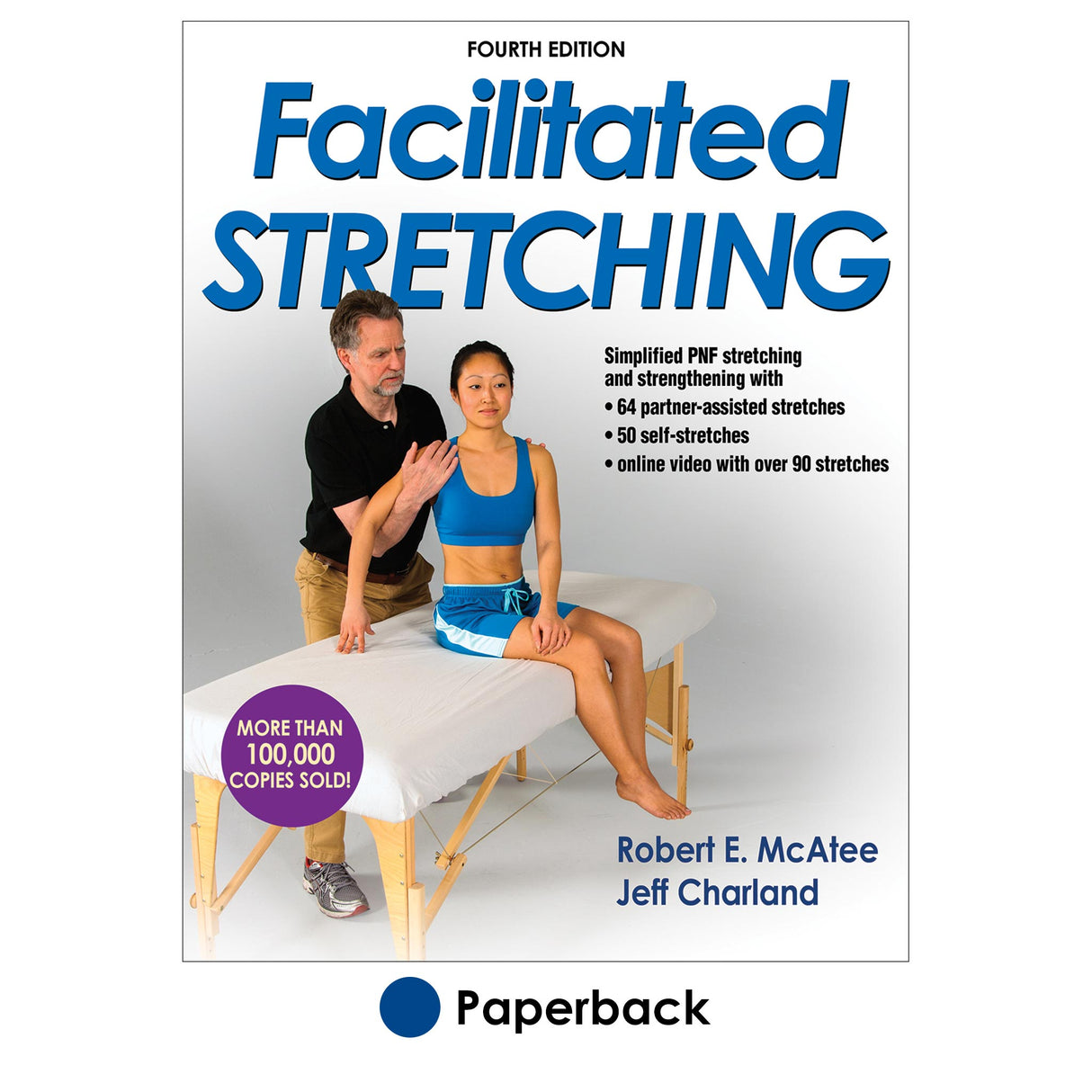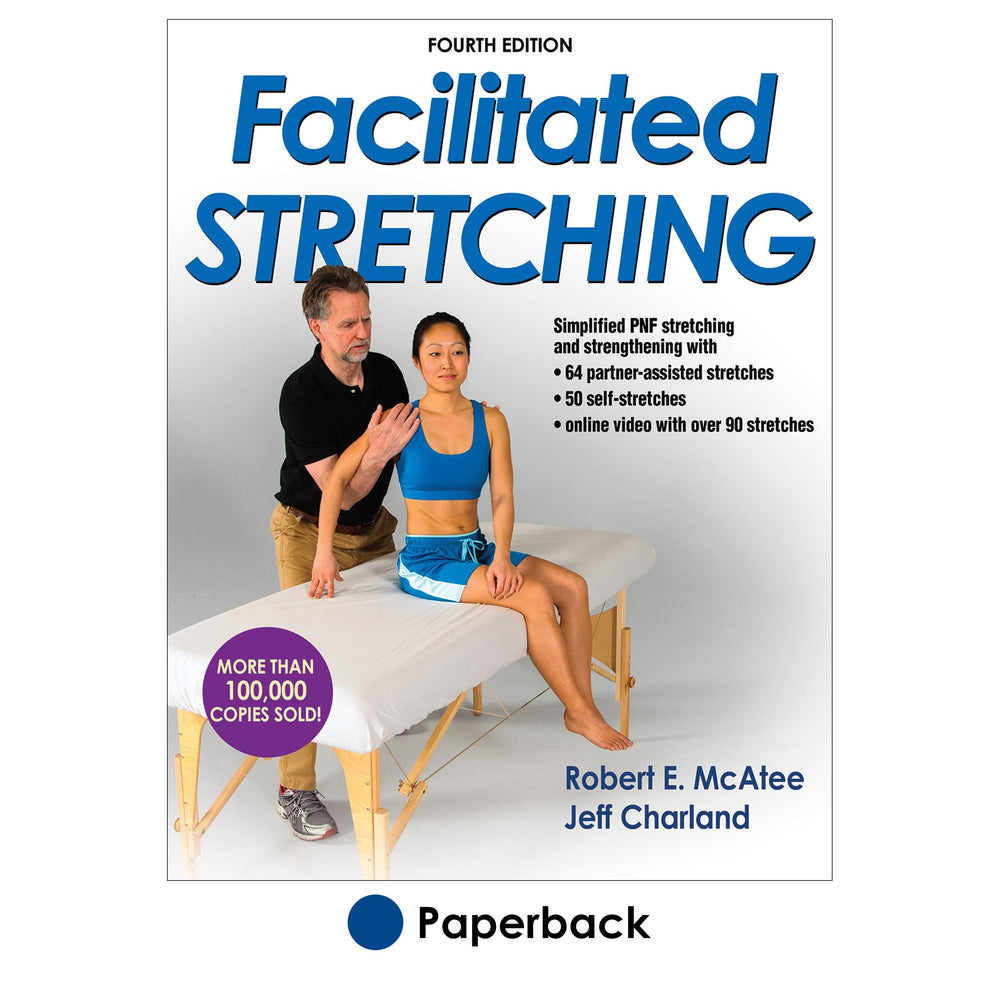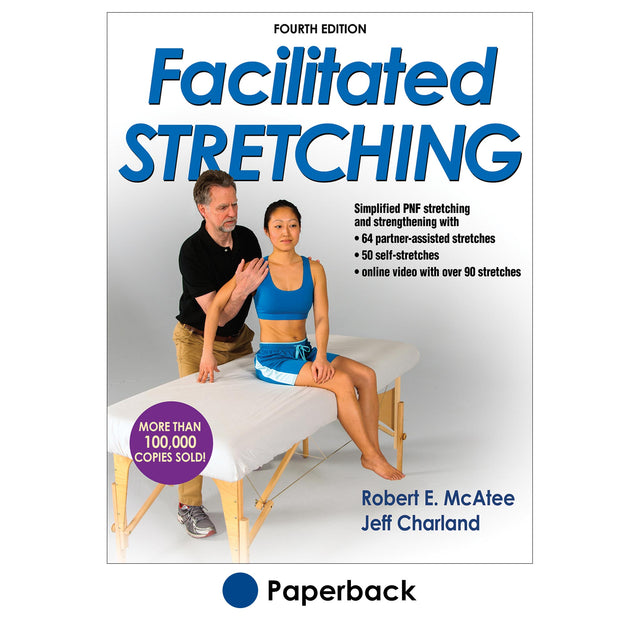Facilitated Stretching-4th Edition With Online Video
Author: Robert McAtee
$42.00 USD
Facilitated Stretching, Fourth Edition With Online Video, remains the most trusted resource for proprioceptive neuromuscular facilitation (PNF) stretching, an effective and easy-to-use method that involves stretching the muscle, contracting it isometrically against resistance, and then stretching it again to increase range of motion. Featuring a full-color interior, streamlined organization, and a new online video package, the fourth edition brings PNF stretching beyond the treatment room with the inclusion of techniques for the gym, workout room, and home.
The fourth edition offers a visual demonstration of PNF stretching techniques with more than 320 photos and illustrations. It includes these updates:
• A full-color interior provides readers with clear images of the techniques discussed
• Graphic elements on selected photos highlight the muscles being stretched as well as the isometric effort for the stretcher and the partner
• Reorganization streamlines the content into two parts, first focusing on the basics and then covering stretches
• Expanded content demonstrates how to incorporate stretches, including strengthening routines, into nontherapy workouts to optimize functional training
• An appendix showcases anatomical planes of motion, anatomical terms, and types of joints
• Online high-definition video presents both treatment room techniques and simplified PNF stretches for nontherapy settings
Facilitated Stretching, Fourth Edition, examines techniques and guidelines for PNF stretches in a variety of settings. Stretches are demonstrated on a treatment table, mat on the floor, chair, cable-pulley machine, and weightlifting bench. Stretches are grouped according to each joint, and the majority of the stretches include both a partner stretch version and a self-stretch version. The accompanying online video then demonstrates more than 90 of these stretches to reinforce proper technique for each stretch as well as four sample stretching routines. Visual icons in the book indicate which stretches are shown in the video.
As in previous editions, specific routines are included for cycling, golf, running, swimming, throwing and racket sports, and now ice hockey. It also includes general stretches for everyday use, plus stretches for those with “rusty hinges.” These ready-made stretching routines make it easy to incorporate facilitated stretching into a workout regimen and take the guesswork out of organizing a stretching routine to match the needs of a specific sport.
For accomplished athletes or those just beginning a fitness program, the regular use of facilitated stretching can help improve flexibility and coordination and boost performance and enjoyment of sports. Manual therapists, massage therapists, athletic trainers, personal trainers, sport physicians, and coaches will find valuable information and techniques for optimizing flexibility, coordination, and performance. Facilitated Stretching, Fourth Edition, provides access to the latest PNF stretching techniques to help assess current muscle function, improve range of motion, increase strength, address overuse injuries, and enhance performance.
Earn continuing education credits/units! A continuing education course and exam that uses this book is also available. It may be purchased separately or as part of a package that includes all the course materials and exam.
Audience
Resource for sports medicine and fitness professionals, including massage and manual therapists, athletic trainers, personal trainers, and coaches, as well as athletes at all levels; also a textbook for courses in these areas.
Part I. The Prerequisites
Chapter 1. Understanding the Basics of Stretching
Soft Tissues Affected by Stretching
Muscle Interactions
Muscle Contractions
Reflexes Relevant to Facilitated Stretching
Types of Stretching
Guidelines for Stretching
Chapter Summary
Chapter 2. Focusing on Facilitated Stretching
PNF History
PNF Basis: Spiral–Diagonal Movement
PNF Stretching Techniques
Facilitated Stretching Guidelines
Detailed Sequence for Facilitated Stretching
Safety Considerations for Facilitated Stretching
Chapter Summary
Chapter 3. Using the Spiral–Diagonal Patterns of PNF
When and Why to Use Spiral-Pattern Stretches
Learning the Patterns Through Free Motion
Facilitated Stretching Using the Patterns
Lower Extremity Stretches Using the Patterns
Upper Extremity Stretches Using the Patterns
Strengthening Exercises Using the Patterns
Chapter Summary
Part II. The Stretches
Chapter 4. Stretches for the Torso and Neck
Oblique Abdominals
Lower Back
Upper Trapezius
Sternocleidomastoid
Scalenes
Suboccipitals
Levator Scapulae
Chapter 5. Stretches for the Lower Extremity
Hip Extensors
Hip Flexors
Hip Lateral (External) Rotators
Hip Medial (Internal) Rotators
Hip Abductors
Hip Adductors
Knee Extensors
Ankle Plantar Flexors
Ankle Dorsiflexors
Toe Flexors
Toe Extensors
Ankle Evertors: Peroneal (Fibularis) Group
Ankle Invertors
Chapter 6. Stretches for the Upper Extremity
Rotator Cuff
Scapular Stabilizers
Additional Muscles That Move the Arm
Elbow
Wrist and Hand
Supinators and Pronators
Chapter 7. Stretching Routines for Specific Activities
Everyday Sequence
Cycling
Golf
Ice Hockey
Running
Swimming
Throwing and Racket Sports
Rusty Hinges
“If a picture is worth 1000 words, then a video is worth 10,000 words, particularly when it includes narration detailing how the body should be positioned and what the stretcher, and the partner if it is a partner stretch, should be doing at each point during the stretch. The use of the video demonstrations moves the book to a much higher level of teaching, and learning for the reader. Readers will be much more comfortable with, and knowledgeable of, doing the stretches and conditioning exercises after they have watched somebody else do it, and had key points explained to them. In sum, the combination of the printed book and the video demonstrations make this an outstanding resource for individuals wishing to enhance their movement ability in a variety of settings, and activities, through the use of effective stretching and movement techniques.”
Gordon Chalmers, PhD—Western Washington University
Safety considerations for facilitated stretching
Understand the function of ligaments

Test package. Features a bank of more than 200 questions in mutiple-choice, true-or-false, and fill-in-the-blank formats. The test package is available for use through multiple formats, including a learning management system, Respondus, and rich text.
Image bank. Contains all the illustrations, photos, and tables from the book, sorted by chapter, that may be used in developing a customized presentation or in creating handouts for students or clients.





